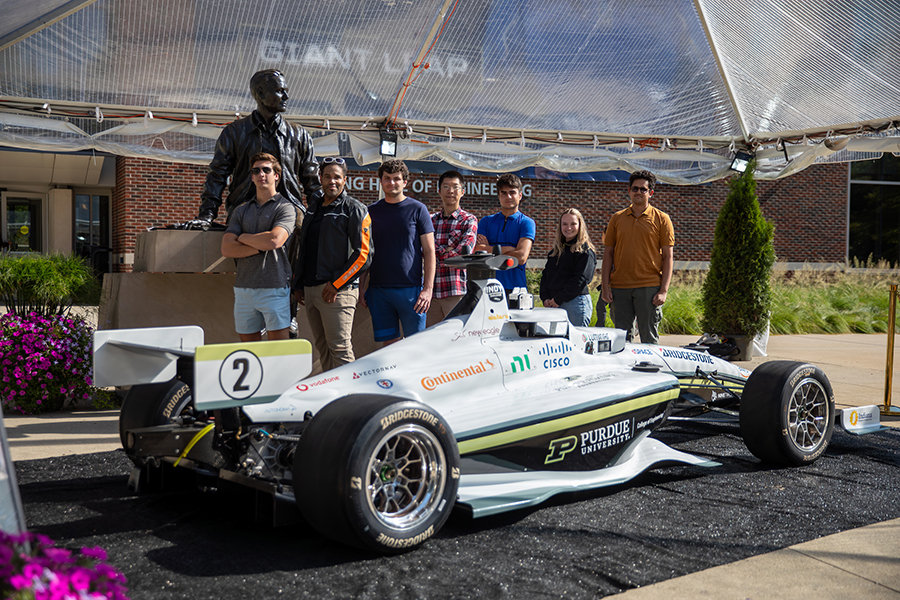Who We Are
Purdue AI Racing Initiative

About the Purdue AI Racing Team
A talented team of graduate students, undergraduate students and faculty who compete internationally in the world’s fastest autonomous racecar competition—the Indy Autonomous Challenge. The team works with the latest sensor technology, including LIDAR, 4D radar, wireless networks, IMU’s advanced cameras and GPS in IAC-made Indy cars with sensor fusion, advanced controls, and AI algorithms for level 4 autonomy in real-life racing venues around the world.

About the Next Gen Autonomous Vehicle Platform IAC AV-24
The Indy Autonomous Challenge (IAC), the global innovator in high-speed autonomy, announced on January 8, 2024 at CES 2024 the launch of its Next Gen Autonomous Vehicle Platform, the IAC AV-24. This cutting-edge platform represents a significant leap forward in autonomous hardware and software technology, propelling the performance of the world's fastest autonomous racecars to new heights. The IAC AV-24 platform and related simulation tools will accelerate the development of AI Drivers capable of operating vehicles safely at speeds greater than 190 mph.
The IAC engineering team has collaborated with leading autonomous hardware and software providers to develop this state-of-the-art robotics system. Global industry partners, including Bridgestone, Cisco, Continental, dSPACE, Luminar, Marelli, New Eagle, NI, VectorNav, and more, have contributed their innovative hardware and software technology and engineering expertise to support the development of the IAC AV-24. This collaboration has resulted in new and enhanced features, including some world-first innovations, which will usher in a new era of high-speed automation:
- World’s First 360-Degree Long Range LiDAR Vision Using 4 Luminar Iris Sensors.
- Advanced 4D Radar Perception Using Continental ARS540 Sensors.
- High Fidelity “Digital Twin” Simulation of IAC AV-24 Allowing AI Driver Training and Head-to-Head SIM Racing powered by dSPACE SIMPHERA Software-in-the-Loop (SIL) simulation and, since 2022, provision of on-vehicle computer technology with the AUTERA AutoBox.
- IAC Custom Engineered Drive by Wire System Including a First-Of-Its-Kind Independent Actuation for Front and Rear Brakes (Patent Filed).
- World’s First Automated Race Control with Two-Way Wireless Communication and Realtime Software Interface powered by Marelli Smart Antenna and WinTax Systems.
- Custom Hardware in the Loop (HIL) Test Rig From NI.
- Improved GPS/GNSS for Enhanced Localization with Sensors from VectorNav.
- Modular Design of IAC AV-24 Integrated Robotics System Allowing for Competent Interchangeability and Integration into Other High Speed Vehicle Platforms (Patent Filed).
After three years and more than 7,000 miles of high-speed racing, the IAC and its industry partners have evolved the robot inside the IAC AV-24 to become smarter and more capable, providing the world’s fastest autonomous racecar with increased functionality that will enable AI Drivers to reach new levels of performance. Moreover, the robot is now vehicle chassis agnostic, capable of operating in multiple vehicle platforms, further expanding its versatility.
Source: Indy Autonomous Challenge Unveils Next Gen Autonomous Vehicle Platform IAC AV-24
About the IAC
The Indy Autonomous Challenge (IAC) is a non-profit corporation based in Indianapolis, Indiana (USA) which organizes racing competitions among university affiliated teams representing 18 universities from around the world. Teams program AI drivers to pilot fully autonomous IAC racecars and compete in a series of history-making events at iconic tracks. Based in Indiana, the IAC is working to establish a hub for performance automation in the state and is harnessing the power of innovative competitions to attract the best and the brightest minds from around the globe to further state-of-the-art technology in safety and performance of automated vehicles. The IAC started as a $1 million prize competition with 31 university teams signing up to compete more than three years ago, representing top engineering and technology programs from 15 U.S. states and 11 countries.
